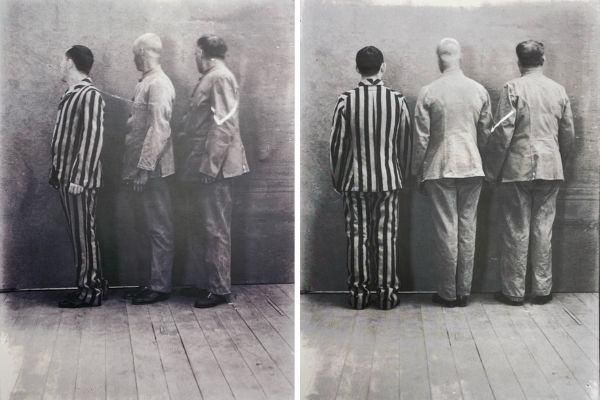Pictured is one of two prisoner dining halls at the old Minnesota State Prison at Stillwater. The photo dates to around 1900. There were two dining halls for prisoners, one reserved for the “first-grade” prisoners and one for the “second-grade” prisoners (the remaining third-grade prisoners dined in their cells). The dining halls had strict rules, that prohibited talking, laughing or even looking around the room. Prisoners were only permitted to eat and drink once the gong had sounded signaling the beginning of the meal and had to stop once the gong ending the meal had sounded. Other rules included not putting meat on the table or vinegar in drinking water (perhaps a form of poor man’s wine?).
Pictured below are the uniforms worn by prisoners. As described in the 1909 book, Convict Life at the Minnesota State Prison, prisoners were grouped into three grades and each grade had its own uniform.
- First-grade (right in photos): This uniform consisted of a “neat gray suit and cap.” First-grade prisoners were permitted to write one letter each week, received a ration of 4 oz. of tobacco per week, and were allowed to have visitors once every four weeks. They also dined in a separate dining room where they received a greater variety of food, such as “butter and other relishes,” which prisoners in the lower grades did not receive.
- Second-grade (middle in photos): Prisoners of this grade wore a black and grey check suit and cap. They were permitted to write one letter every two weeks, received “a small ration” of tobacco each week, and were allowed visitors once a month. They also had their own dining room but were served food of less variety than the first grade.
- Third-grade (left in photos): Uniforms were black and white striped. They received no writing, tobacco or visiting privileges and had their meals served in their cells.According to “Convict Life…”, all new prisoners donned the second-grade uniform when they were admitted to the prison. The book does not confirm, but we presume that their subsequent behavior would lead to either promotion or demotion.
These photographs are part of the John Runk Photograph Collection at the library. Dining hall rules and other aspects of prison life can be found in Convict Life at the Minnesota State Prison. Although not credited, John Runk is believed to have been the photographer for many of the photographs that appear in the book. He is also known to have been the photographer for many of the prison’s mugshots.This photo is part of a large group of prison photographs in the John Runk Photograph Collection. They, as well as the other photos in the Runk collection, can be viewed in the St. Croix Collection at the library.

